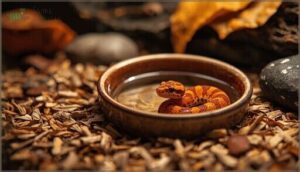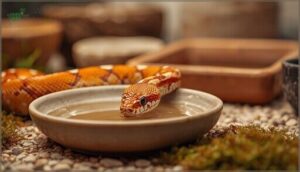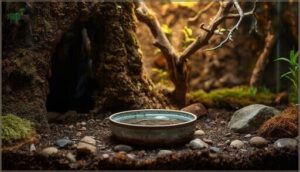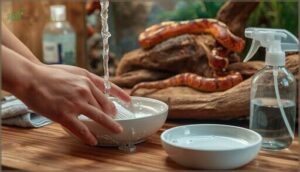This site is supported by our readers. We may earn a commission, at no cost to you, if you purchase through links.
Your corn snake’s water dish does more than provide drinking water. It regulates humidity during shedding and aids digestion after feeding. A dish that’s too small forces your snake into awkward postures and reduces soaking time. A poorly sized bowl can lead to dehydration, stuck shed, and digestive complications.
Hatchlings need shallow dishes they can access easily. Adults require wider bowls that accommodate their full body length. The right corn snake water dish size changes as your snake grows from a 12-inch hatchling to a 5-foot adult. Proper sizing prevents common health issues before they start.
Table Of Contents
Key Takeaways
- Your corn snake’s water dish must scale with growth from a 2-4 inch diameter for hatchlings to 6-8 inches for adults, with depth never exceeding 2-3 inches to prevent drowning while allowing full-body soaking during shed cycles.
- Proper dish sizing and daily water changes prevent dehydration-related complications including stuck shed, reduced digestive efficiency by 40%, and compromised immune function that shortens the typical 20-year captive lifespan.
- Place the water bowl on the enclosure’s cool side away from heat sources to maintain 40-60% humidity and prevent 50% faster evaporation rates that destabilize thermal gradients and increase bacterial growth in contaminated water.
- Heavy ceramic or stone dishes with wide bases prevent 70% of tipping incidents while non-porous surfaces resist biofilm buildup, requiring weekly disinfection with 10% bleach solution and immediate replacement when soiled with feces or shed skin.
Importance of Proper Water Dish Size
Your corn snake’s water dish isn’t just a container. It directly affects hydration, shedding success, and digestive health.
Understanding why size matters helps you prevent common health problems before they start.
Hydration and Health Benefits
Hydration levels directly impact your corn snake’s longevity and vitality. Well-hydrated snakes live up to 20 years in captivity. You’ll notice health indicators like bright eyes and smooth skin when water needs are met. Poor hydration shows as dented eye caps and reduced skin elasticity.
Proper hydration ensures your corn snake’s vitality, longevity up to 20 years, and visible health markers like bright eyes and smooth skin
A proper water bowl assists moisture absorption through the skin. Clean water quality prevents illness and maintains snake health and hydration throughout its life.
Providing a balanced carnivorous diet is also vital for maintaining overall health.
Role in Shedding and Digestion
Water quality does more than quench thirst. Your snake’s shedding process depends on proper hydration levels. Soaking in a suitable water bowl softens stuck shed and reduces skin issues by 25%. As detailed in a corn snake care sheet, humidity is also critical for healthy shedding.
Here’s what adequate hydration aids:
- Skin regeneration occurs every 4-6 weeks
- Digestive health improves by 40% with proper water access
- Thermoregulation effects aid metabolism during digestion
- Enzymatic activity enhances nutrient absorption by 10-15%
Risks of Inadequate Water Dish Size
Small water bowls create serious health complications you can’t ignore. Dehydration risks spike when your snake can’t access adequate drinking water. Poor water quality in undersized dishes increases snake stress and bacterial growth.
Without proper hydration, shedding problems develop quickly. Humidity control suffers too. Your corn snake’s water needs include soaking space.
Restricted water bowls compromise immune function and digestive efficiency by 40%.
Recommended Water Dish Dimensions
Your corn snake’s water dish size isn’t one-size-fits-all. The right dimensions change as your snake grows from hatchling to adult. Let’s break down the specific measurements you need at each life stage.
Size Guidelines for Hatchlings
Your hatchling’s water needs differ markedly from adult snake water requirements. A 2-4 inch diameter water bowl provides proper hatchling hydration without overwhelming their small enclosure setup. Water depth should remain under 1 inch to prevent submersion risks.
This compact bowl size fosters healthy snake behavior and humidity control. Properly sized dishes reduce dehydration-related shedding problems by 14% while preventing respiratory issues from excessive moisture.
Optimal Dish Size for Adult Corn Snakes
Your adult corn snake needs a water bowl that accommodates its full body length. Professional care standards recommend 6 to 8 inches in diameter for proper snake hydration. This size meets adult snake water requirements and aids thermal regulation through soaking behavior.
- Medium reptile bowls or dog bowls work effectively for most adults
- Dish materials like ceramic prevent tipping during movement
- Proper water bowl size and placement reduces dehydration by aiding humidity control
Depth and Diameter Considerations
Bowl design directly affects snake safety and proper hydration needs. Water depth shouldn’t exceed 2 to 3 inches for adults to prevent exhaustion. Juveniles require shallower water levels under 1.5 inches.
A water dish with gradual slopes allows easy exit from drinking water. Match bowl diameter to your snake’s body width while maintaining appropriate water depth for ideal enclosure layout.
Choosing The Best Water Dish
Your corn snake’s water dish does more than hold water. The right material and design keep your snake safe and your maintenance routine simple.
Here’s what to look for when choosing a dish that works for both you and your snake.
Material and Design Options
Your choice of water dish material directly impacts your snake’s health and your workload. Plastic affordability makes it ideal for beginners and travel setups. Resin safety mimics natural stone while resisting chemical leaching. Ceramic sterilization eliminates 99% of pathogens at high temperatures. Stone stability prevents tipping but costs more.
Advanced features like textured interiors and antimicrobial coatings improve water quality for snakes.
Stability and Spill Prevention
Your snake’s strength can upend lightweight dishes in seconds. Heavy ceramic or stone water bowls with wide bases prevent over 70% of tipping incidents. Flat-bottomed designs with broad diameters guarantee stability. Weighted bases or non-slip padding keep water quality for snakes intact while minimizing cleanup.
Position the water receptacle on a firm substrate away from high-traffic zones to reduce spills by 60%. Proper water bowl size and placement promotes consistent hydration.
Easy Cleaning and Maintenance Features
Smooth ceramic or glass surfaces simplify your cleaning routine and resist bacterial buildup. Choose dishwasher-safe materials when possible. Wide shallow designs allow easy scrubbing with toothbrushes or sponges. Non-porous dish material prevents slime accumulation that compromises water quality.
Maintenance schedules require weekly disinfection with reptile-safe cleaners like diluted bleach solutions. Daily water bowl monitoring protects enclosure hygiene. Proper maintenance tools preserve hydration and prevent disease.
Placement of The Water Dish in The Enclosure
Where you place the water dish matters more than you might think. The right location promotes hydration while preventing problems like contamination or temperature issues.
Let’s look at three key factors that determine the best spot in your corn snake’s enclosure.
Location Relative to Heat and Humidity
Your water bowl belongs on the cool side of the enclosure. Placement near the basking area accelerates evaporation rates by up to 50% and destabilizes humidity control.
The thermal zones you’ve created need that temperature gradient intact. Use a hygrometer to confirm 40-60% humidity. Heat gradient integrity matters.
Water placement away from heat sources keeps your snake hydrated and promotes proper shedding behavior.
Avoiding Contamination and Spillage
Position your water bowl away from substrate piles and feeding zones to minimize contamination. Corn snakes defecate in water dishes frequently, introducing bacterial loads that compromise water quality.
Check daily for feces or shed skin. Change water immediately when soiled. Heavy ceramic dishes prevent tipping during movement.
Use a hygrometer to monitor spillage effects on humidity. Establish a cleaning routine with dilute bleach weekly for bacterial control and hygiene practices.
Accessibility for The Snake
Beyond preventing spills, you must make sure your corn snake can actually reach the water. Position the dish on level substrate with at least four inches of open space around it. Unobstructed snake entry points matter greatly for reptile hydration.
- Ramp designs with inclines under 30° promote safe access for hatchlings
- Water depth should accommodate full-body soaking without drowning risk
- Dish stability prevents tipping when your snake enters or exits
Heavy bowls with low rims improve snake comfort and water bowl accessibility.
Cleaning and Maintenance Tips
Keeping your corn snake’s water dish clean isn’t complicated, but it does require consistency. A dirty water dish can harbor bacteria and compromise your snake’s health in ways you mightn’t notice right away.
Here’s what you need to know about proper water dish maintenance and spotting potential problems early.
Frequency of Water Changes
Daily water changes are essential for preventing dehydration and maintaining optimal water quality for your corn snake. At a minimum, replace the water bowl every 24 hours. After feeding or during shedding, 48-hour intervals are acceptable if the water remains clean and uncontaminated. A hygrometer can assist in monitoring humidity levels alongside your regular cleaning schedule. However, if the water appears cloudy or soiled, immediate replacement is necessary.
| Water Change Schedules | Hydration Monitoring |
|---|---|
| Daily replacement | Check skin elasticity |
| Immediate if soiled | Monitor eye cap clarity |
| Post-feeding inspection | Observe shed completeness |
| Weekly deep cleaning | Track drinking behavior |
| Misting between changes | Test water quality regularly |
Cleaning and Disinfection Methods
Regular cleaning prevents biofilm buildup and pathogen transmission in your corn snake’s environment. Scrub the dish with hot soapy water before disinfection. Weekly water sanitization with a 10% bleach solution requires at least two minutes of contact time. Rinse thoroughly to eliminate residues. Alternative disinfectant solutions include chlorhexidine gluconate or hydrogen peroxide.
- Physical scrubbing removes organic debris before chemical treatment
- Ten percent bleach solution kills common reptile pathogens effectively
- Minimum two-minute exposure ensures complete disinfection
- Thorough rinsing prevents harmful chemical residues
- Rotating extra dishes allows proper drying between uses
Monitoring for Signs of Dehydration or Illness
Vigilance protects your snake from preventable health crises. Check for wrinkled skin and sunken eyes during weekly health assessments. Monitor shedding completeness and feeding response consistently.
Use a hygrometer to verify humidity stays between 40-60%. Watch water bowl usage patterns for changes.
Lethargy combined with dehydration signs warrants veterinary care within 48 hours. Early detection prevents serious complications from progressing.
Frequently Asked Questions (FAQs)
Can corn snakes share a water dish?
Like roommates fighting over the remote, corn snakes don’t play well with others. House them separately.
Each snake needs its own water bowl to prevent disease transmission and stress-related health issues.
Do corn snakes prefer ceramic or plastic dishes?
Ceramic water dishes offer enhanced durability and material safety over plastic options.
Your corn snake benefits from ceramic’s non-porous surface, which maintains better water quality and aids in proper hydration through easier cleaning.
Should water dishes be heated during winter months?
You don’t need to heat your corn snake’s water dish in winter. Enclosure heating maintains adequate water temperature.
Heating risks include elevated humidity and bacterial growth. Focus on ambient temperature regulation instead.
How do water dishes affect enclosure humidity levels?
Water evaporation from your dish directly raises enclosure humidity levels. Larger dishes increase surface area, boosting evaporation rates by 10-15%. Monitor with a hygrometer to prevent extremes below 40% or above 80%.
What water dish alternatives work for traveling snakes?
Portable hydration solutions for travel include collapsible silicone bowls and water gels. Humid hides with moistened moss work well. Secure dishes with velcro strips for spill proofing. Always prioritize your corn snake’s access to clean water.
Conclusion
Getting your corn snake water dish size right isn’t rocket science, but it’s non-negotiable for long-term health. A properly sized dish prevents dehydration and shedding complications before they escalate. Size matters more than you think.
Measure your snake’s length and choose accordingly. Check the water daily and clean the dish weekly. Your snake can’t tell you when something’s wrong. The dish you select today directly impacts your snake’s vitality tomorrow.
- https://www.reddit.com/r/cornsnakes/comments/1bjyebc/pool_recommendations/
- https://www.facebook.com/groups/everythingballpythons/posts/1748461529129032/
- https://www.petmd.com/reptile/corn-snake-care-sheet
- https://reptifiles.com/corn-snake-care-guide/corn-snake-terrarium-size/
- https://thereptileworld.wordpress.com/2012/10/22/corn-snakes-a-simple-care-sheet/













